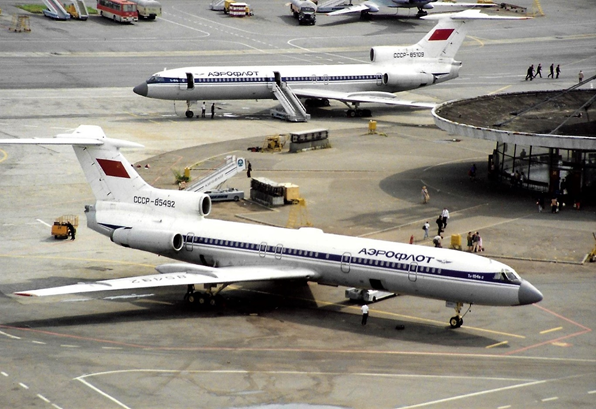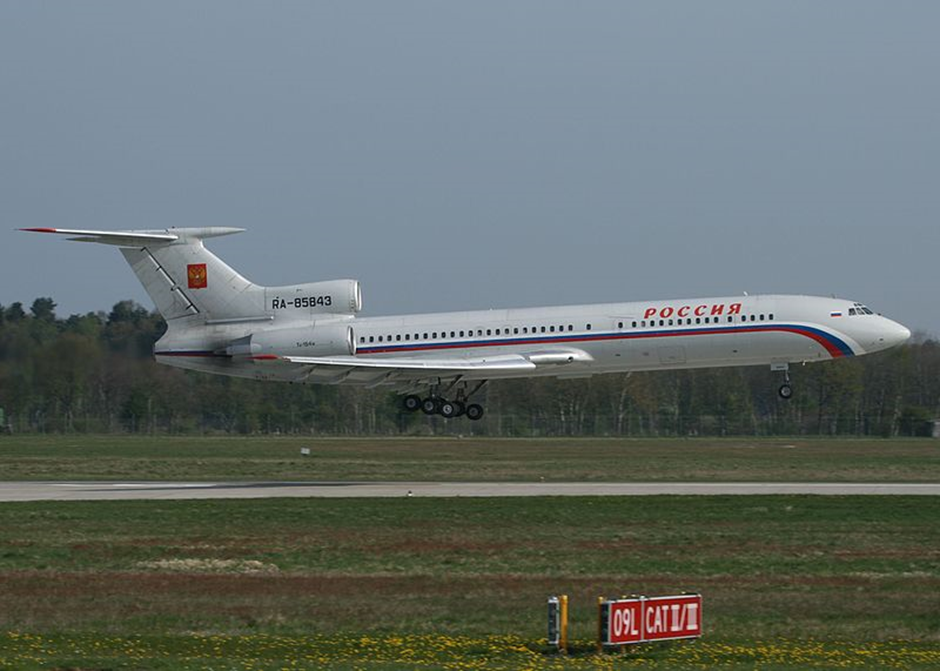


In the 1960s three new tri-jet medium-range aircraft arrived on the airliner scene. First to fly in 1962 was the British de Havilland Trident which would see 117 examples built. Next up was the much more successful American Boeing 727 with the first of 1,832 examples first flying in 1963. The last of the trio was from the Soviet’s Andrei Tupolev design bureau, the Tupolev Tu-154 which first took to the sky in 1968. Production ended in 2009 with 1,026 examples seeing service.

The Tu-154 was designed to replace the first generation Soviet jet airliner the Tu-104 plus the turbo prop Ilyushin IL-18 and Antonov An-10 airliners in service with Aeroflot. It was to become the medium haul workhorse within the USSR and beyond for several decades. Designed by the Andrei Tupolev design bureau, production was at one of the largest aviation plants in the Soviet Union, the Aviakor factory at Samara in central Russia. The first Tu-154 had its maiden flight on 4 October 1968 and deliveries to Aeroflot (at that time the only airline in the USSR) would start in 1970 with freight services beginning in 1971 and passenger services following in 1972. Initially powered by three Kuznetsov engines later models had these replaced by more powerful, and more economical, Soloviev engines in the Tu-154M variant.

Slightly larger than the Boeing 727 the Tupolev could carry 164 passengers in a two-class layout with six-abreast seating. It could also be adapted to the ‘winter fit’ which removed some seats and added extra wardrobes for passenger’s winter coats. As has been previously stated the Tu-154 was seen as a replacement for the IL-18 which could happily operate off the many poor runways around the smaller towns of the USSR. To be able to use the same runways the much heavier Tu-154 was fitted with a large undercarriage with three wheels in tandem on each wing. These didn’t retract into the wing or fuselage but instead folded rearwards into pods at the back of the wing. The flight crew would comprise two pilots a flight engineer and a navigator. On the later Tu-154 models, just like the Trident, there was a triple channel autopilot fitted which enabled the Tupolev to operate down to Cat 2 weather conditions, but it is believed this still required the pilot to make the final landing, unlike the Trident’s fully automatic landing system. Also just like the Trident wing cracks began to appear on the early Tupolev’s, so in 1975 a new variant the Tu-154B was built with a redesigned and stronger wing

There would be many different variants over the life of the programme including a pure freighter version with a large fuselage cargo door the Tu-154S, VIP versions for the government and military plus electronic intelligence gathering aircraft sold to the Chinese as the Tu-154MD. One interesting variant was the Tu-154M-100. This version featured many upgrades including western-built avionics such as TCAS, EGPWS and flight management computers. Just three were built in 1998 and were given to the Slovakian government as payment for a debt owed to that country by Russia, they were operated by Slovak airlines until sold back to Russia in 2003.

17 other countries would operate the Tu-154 mainly those in the old Soviet Bloc. Back in the 1980-early1990 era most airports in Europe would see a Tu-154 from airlines such as LOT (Poland), Balkan (Bulgaria), Malev (Hungary), CSA (Czechoslovakia), Aeroflot, Tarom (Romania) or even Interflug (East Germany). More exotic airlines such as Cubana (Cuba), Air Koryo (North Korea) and several African countries also operated the type as either an airliner or a Government VIP aircraft. With the breakup of the former USSR many ex Aeroflot aircraft were repainted into the colours of the newly independent state’s airlines and in Russia many smaller airlines were formed and took over some of the airliners from Aeroflot. Aeroflot themselves had to re-register its aircraft from the old CCCP prefix to RA for Russia. They also eventually introduced a new blue-based colour scheme which some of the TU-154s would wear. However with the breakdown of the old soviet system Aeroflot was now free to buy western built aircraft and the writing was on the wall for the old soviet aeroplanes.

Like many soviet airliners of the era the Tu-154 suffered its fair share of accidents. 73 were involved in incidents of one kind or another causing the loss of the aircraft, many also resulting in a large loss of life. 2010 saw the loss of a Polish presidential flight aircraft which led them to ground their other aircraft, all on board including the Polish President were killed in the crash. In 2011 the Russian authorities recommended all Tu-154B aircraft be retired and in the same year the Iranian authorities grounded all remaining Tu-154 aircraft in Iran due to the high number of accidents. 2016 saw a Russian aircraft crash killing the official military Red Star choir. Following this all Russian Tu-154s were grounded for a while pending an investigation into the crash.

In January 2010 after 40 years of service Aeroflot announced it had retired its fleet of Tu-154s the last flight having taken place on 31 December 2009. The following year Uzbekistan airlines followed suit and gradually the Tu-154 began to disappear from our skies. The Russian military continue to use their small fleet for various operations but by October 2020 ALROSA, the last Russian airline to fly the type, grounded its fleet and the Russian civil registered aeroplanes were all gone. Today there are thought to be under 50 Tu-154s still active, most with the Russian Government/military.

There is just one airline still operating the type on scheduled passenger service and that is the North Korean airline Air Koryo who have two in service. The Chinese air force continue to fly their electronic warfare aircraft and a few others are operated elsewhere on charter or Government work. When the Andrei Tupolev design bureau came up with the Tu-154 it wasn’t the first Soviet airliner to feature three jets. That award went to the Yakolev Yak-40 a 24-seater feeder airliner that first flew in October 1966. It may not have been the first but the Tupolev Tu-154 was certainly the most charismatic.


Another classic airliner that had seemed to be around for ever is about to leave our skies to the hoards of Boeing 737 and Airbus A320s, sadly gone are the days when airports could boast of something exotic from behind the iron curtain. Let’s end with another picture of the airline that made the Tu-154 what it was, Aeroflot and the last paint scheme it applied to its Tu-154 fleet.

‘till the next time Keith
Registered Charity No. 285809